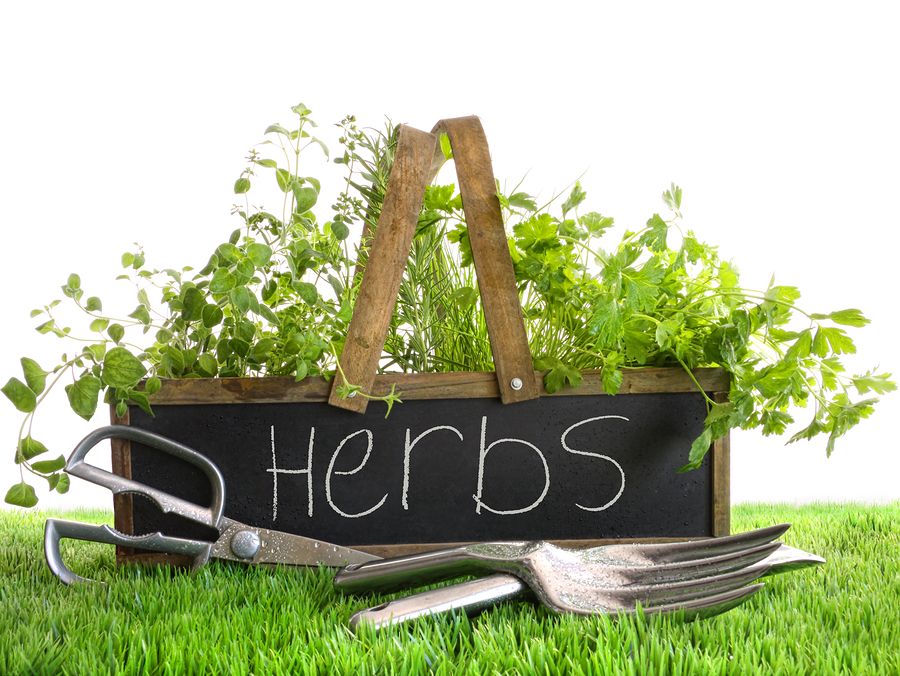Want to know all the basics for creating your own herb garden? Celeste Longacre, author of “Celeste’s Garden Delights” and accomplished gardener for over 35 years offers advice for starting your own herb garden.
FAQ on Herb gardening basics
Get quick answers to all the basics of starting an herb garden. Click on the hyperlink time stamps for quick 30-90 second answers.
When should you start planting for your herb garden?
- 5:02 When should you start an herb garden? What should you buy from the nursery or start from seed? Celeste kicks off her herb garden sometime in Feb/March with planting onions. She buys containers of tomatoes, peppers, and paprika from the nursery. As soon as the snow melts, she plants lettuce, peas, beets, carrots, cucumbers, summer squash, parsnips, and snow peas seeds. Celeste notes the few plants that are fine with frost such as Lettuce, Swiss chard, peas, snow peas, broccoli, cabbage, and brussel sprouts among other veggies. Get a full list by signing up to Celeste’s email blasts: http://celestelongacre.com/subscribe/
- 3:13 Can you plant fresh basil with roots? Celeste points out that once a plant is uprooted it will not grow. (Note: CJ has planted chive and green onions that seem to survive).
- 1:21 What herb should you plant if you want to grow fresh greens during the winter? Celeste suggests, Mache, a green you can grow indoors during the winter. She starts planting Mache seeds in October to grow greens for the entire year. Get more info here: http://celestelongacre.com/planting-mache/
- 36:06 Where should you buy seeds? Celeste recommends getting local seeds that have been acclimated and proven to grow successfully in your environment.
Where should you plant your herb garden?
- 4:26 How to get herbs to grow indoors? If you want to try growing herbs indoors, make sure to pick the window that gets the most sun. Celeste encourages using a window seal that faces South.
- 29:27 What herbs can you try planting indoors? You can try thyme, lettuce, chives, basil, and most herbs.
- 8:40 What herbs are good for growing in very tight spots? Celeste suggests creeping thyme as an herb you can plant in between flagstone path.
- 7:10 Celeste shares how she started her garden with raised beds and stones.
What are moron proof herbs?
- 10:28 What are some hearty plants that are good for confidence building? There are few fail proof herbs. Start off with thyme, oregano, and basil (summer). You may notice a large variety of veggies at the store. They may all be the same in terms of hardiness so you should base your pickings on what will compliment the flavors in your food.
How do you prepare the soil?
- 12:30 What is the best kind of soil to buy? Local soil is best as it encourages healthy roots, nutrients, and water retention, which is what plants love. The key to having great soil is keeping it rich with live microorganisms that help keep your plants healthy. Celeste suggests adding kelp meal and Alphalpha meal to add fluff and minerals into the soil. After you add the meals, then mix everything up with a rake. (Find out more kelp meal: http://garden.lovetoknow.com/wiki/Kelp_Meal_Fertilizer); (http://www.gardeningknowhow.com/garden-how-to/soil-fertilizers/fertilizing-with-alfalfa-meal.htm)
- 33:02 How do you prepare soil for planting pots? If you have established pots with perennials then you should change the soil every few years. If you are using a new pot to plant in, then make sure to replace the existing soil with fresh soil every year so that it will have fresh nutrients to draw from. You can start by placing an unbleached paper towel at the bottom of the pot to create drainage and prevent the soil from slipping through the bottom. Follow the instructions above by placing some manure, alpha meal, etc.
Gardening supplies (Potting soil, size of pots, fertilizer)?
- 15:30 What is Celeste’s favorite gardening essential? Celeste reveals her favorite planting fork, a mini pitchfork, which is great for weeding and shoveling soil. It can also be used to test if a plant needs water.
- 31:29 What are other essential tools you need? Celeste says the only two things you’ll need are gardening gloves and a pitchfork for loosening the soil when preparing the bed for planting.
How to plant a seed?
- 12:04 How do you plant from seeds? Celeste gives a demonstration on how to properly plant lettuce, carrots and beets seeds.
- 13:35 How do you plant seeds using a broadcast method? Celeste shows how to plant a lettuce leaf using a broadcast method and thinning out when lettuce reaches a spoon size.
- 13:57 How do you plant in rows? Celeste demonstrates with carrots and beets on how to plant veggies that need to be placed very close together in thick rows. Later you thin the smaller plants out.
- 15:01 How deep should you plant the seed? The seeds need to be planted twice the depth of their thickness. Spread your soil mixture or compost over the top once seeds are planted.
- 19:30 More tips on planting lettuce: Initial leafs are pretty small. The more you thin them the more they grow. 30:46 Celeste’s tip is to plant lettuce all year long so the leaves don’t get bitter.
Watering Plants
- 15:30 How can you test if the plant needs water? Celeste shows how her favorite gardening tool can be used to test if a plant needs water. Simply stick the mini pitchfork into the soil and if it comes out dry, then your plant needs water.
- 16:50 How much water is too much? Initially plants need a lot of water. Don’t worry about overwater as soil can absorb a large amount of water. If you notice water is pooling up at the top it means that you don’t have enough organic matter in your soil (compost).
- 17:38 What is the best method for watering? You want to water until the soil looks very moist and saturated like a sponge. Continue watering every day until the plant comes up and breaks the soil. Once the plant pops above the soil, then let the top part of the soil dry out a bit so that the roots grow downward toward the earth.
- 37:42 How to keep plants watered while on vacation? Try self-watering planters and then place 20 pieces of wet B&W newspapers on the top to keep moisture in.
How to harvest?
- 18:54 How long till the seed grows into a plant? Celeste said it varies. For example, lettuce, zucchini, and summer squash plants grow quickly (5-6 days), whereas carrots can take 10-14 days.
- 21:35 How do you harvest plants? Basil grows up vertically. To harvest, pinch the buds and tops off so to force the plant to grow outward. Don’t let the basil flower or it will change the flavor. You can pick cucumbers, and summer squash when they are about 6″ long. If you pick them when they are longer, they won’t taste as good. September is the best time to harvest root vegetables like carrots and beets. You want to thin them out throughout the year. In terms of root vegetables, the bigger they are the longer they stay fresh in the root cellar. Parsnips can stay outside until the spring.
- 24:17 How do you cut down herbs? You can cut certain plants almost down to the soil (thyme, oregano). You want to cut these herbs every few weeks throughout the whole year to prevent the plant from flowering.
Drying Herbs
- 26:37 How do you dry out herbs? You dry out herbs by putting them on a cookie sheet and placing them in an oven with a pilot light, OR at a low temperature with the door open. Another option is to tie the herbs up in a bundle and hang from the ceiling. Once the herbs dry up they will crumble at the touch. You want them to be completely dry so they don’t mildew. Preserve the dried herbs by placing them in a bag or glass bottle. Make sure to take off the stems when cooking J.
- 28:26 How to make garlic powder? Take dried garlic and crush it down in a blender.
Making a Fruit Kvass from your vegetable/fruit scraps (fermented drink)
- 43:40 How to make a Kvass from fruit? Celeste demonstrates how to make a probiotic drink from scratch. Place fresh fruit scraps (blueberry, blackberry, orange, strawberry, beets, etc.) onto a cookie sheet. Put the cookie sheet in the freezer. Once frozen, place the frozen scraps into a mason jar. You can to use any left over vegetables and fruits from the garden because you want a variety of different types of bacteria. Add salt to the jar for fermentation. You can also add homemade whey for added bacteria. Add water but leave some head space at the top for air. Shake well. Cover the jar with a towel and place it on the counter for 2-3 days. Shake it a few times each day and let the gases out by quickly opening and closing the lid. On the 2nd or 3rd day, strain the juice out and place in the refrigerator to keep it fresh. The Kvassa acts as a detox for the body so you don’t want to drink too much too soon. Celeste recommends mixing a teaspoon of kvassa into water to first build up your internal system.
Common mistakes in growing herbs
- 41:21 Other tips for novices: Don’t let things dry out. Water. Water. Water early in the morning or late in the evening. During the day, water may dissipate more quickly and cause plant leaves to burn. Once a plant is well established with deep roots, it is best to saturate the soil.
About
 Celeste Longacre is an accomplished gardener who has been growing most of her family’s vegetables for over 35 years. Celeste preserves the garden’s bounty by canning, freezing, drying, and fermenting it as well as storing her produce in a root cellar. She and her husband, Bob, live sustainably in a handmade octagonal home. During the cold winter months, their heat is provided by the firewood that Bob cuts. Much of their electricity is generated with an array of solar panels.
Celeste Longacre is an accomplished gardener who has been growing most of her family’s vegetables for over 35 years. Celeste preserves the garden’s bounty by canning, freezing, drying, and fermenting it as well as storing her produce in a root cellar. She and her husband, Bob, live sustainably in a handmade octagonal home. During the cold winter months, their heat is provided by the firewood that Bob cuts. Much of their electricity is generated with an array of solar panels.
Celeste has also been the astrologer for “The Old Farmer’s Almanac” for the past twenty years.
Photo: Sasha Salzberg
#Garden tools, Garden supplies, Year around gardening, Garden soil, garden box, indoor gardening, gardening ideas, garden plans, vegetable garden ideas, water plants, how to dry herbs, kvass, plant seeds, planting seeds, buy soil, planting lettuce, how to plant lettuce, thyme, basil

